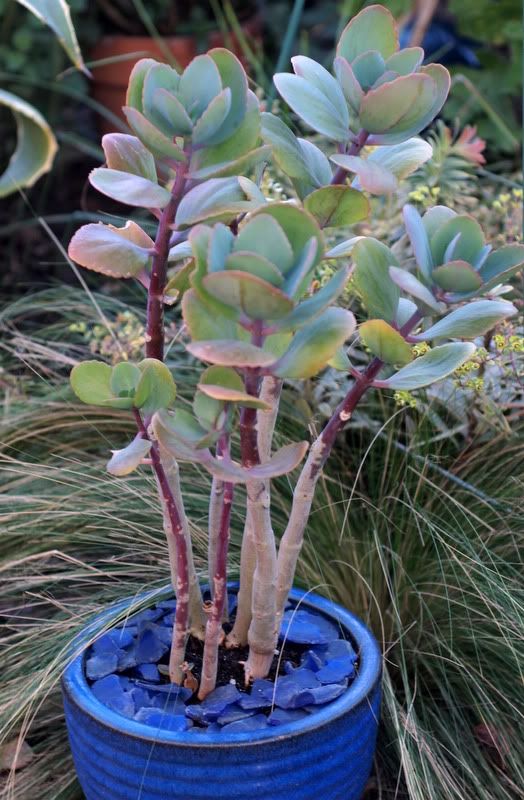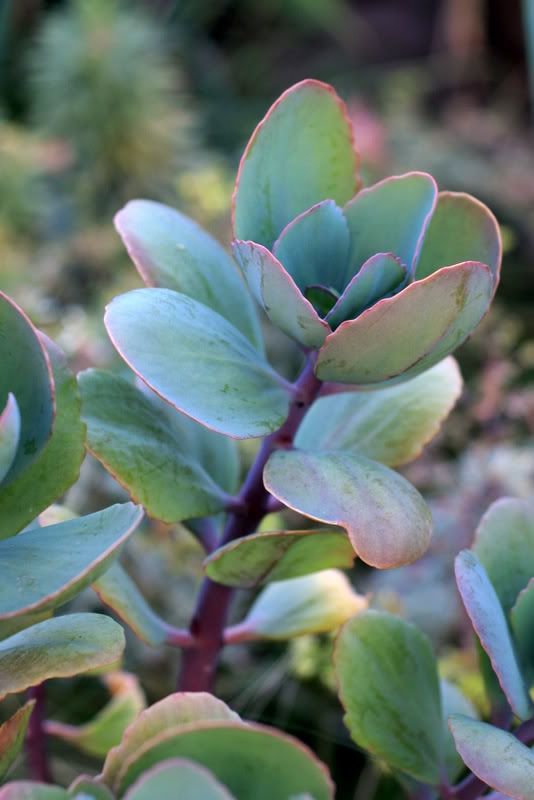All succulents can be described as fleshy to some degree, but this kalanchoe is positively indecent, a real fleshpot. A tall, upright succulent to 3 feet.

How to describe the color? There actually exists a means to describe the complex coloring of this kalanchoe’s leaves in one word: Peachblow.
“Of the delicate purplish pink color likened to that of peach blooms; – applied esp. to a Chinese porcelain, small specimens of which bring great prices in the Western countries.”
Turquoise leaves suffused with peachblow. The peachblow will most likely not be as pronounced in summer as with winter temperatures.
I circled around this kalanchoe at California Cactus Center last week, repeatedly tried to walk away, then finally plunged in, carefully stepping through the surrounding pots bristling with spines and spears, grabbed it, and headed directly to the counter before I could change my mind again. Trying to keep a top-heavy, brittle-stemmed succulent upright while driving could probably be added to the list of dangerous activities to avoid at freeway speeds, but way down the list below texting. Possibly similar to having a boisterous pet in the car, though.

San Marcos Growers says its yellow flowers are not reliably produced every spring. (With leaves like that, I think I can bear the disappointment.) SMG’s entry on this succulent includes a charming theory for the etiology of the naming of the genus kalanchoe: “The name Kalanchoe is somewhat of a mystery – there is some thought that it comes from a phonetic transcription of the Chinese words “Kalan Chauhuy†meaning that which falls and grows, likely in reference to the plantlets that drop from many of the species, but others believe it from the ancient Indian words “kalanka†meaning spot or rust and “chaya†meaning glossy in reference to the reddish glossy leaves of the Indian species K. laciniata.” SMG also notes that K. grandiflora is often confused with K. marmorata, another fleshpot but with maroon spots.
My Hortus Third helpfully informs that “The name is pronounced with four syllables.” Kal-an-cho-e.


i love the background of the cobalt blue! lovely!
The delicacy of color is indeed irresistable. More Coco than Elsa.
As one who is a total sucker for red stems , I applaud your purchase. I further recommend a box (empty wine box works for me) and an old beach towel in the car at all times. Put plant in box, stuff towel around the pot. Works every time, even on windy roads.
LD, that was the only empty pot at the moment, but what doesn’t look great with cobalt blue?
Hoov, true enough! I need to encourage my inner Elsa more.
Kathy, though I rarely splurge on big specimens, let’s face it, I need to keep a setup like that in the car.
I had to re-read the title when I saw the pictures. It looks like a variety of sedum. I fell in love with some of the Flapjack Kalanchoes and tried to get them to grow, but I think they got too much rain and never thrived.
I remember seeing this plant. We used to have them in our garden when I was young. Are they in the same family as Aloe Vera?
Les, it does have that Sedum sieboldii bluey scalloped leaf thing going, but the leaves are much larger.
Shine, the kalanchoes are in the crassulaceae family, aloes in the aloeaceae, but all are succulents.
This is species named saião em Brazil (Rio de Janeiro State), where it is very edible. Very delicious. In natura salad only with salt (cut the leaves and plus salt ou salt).